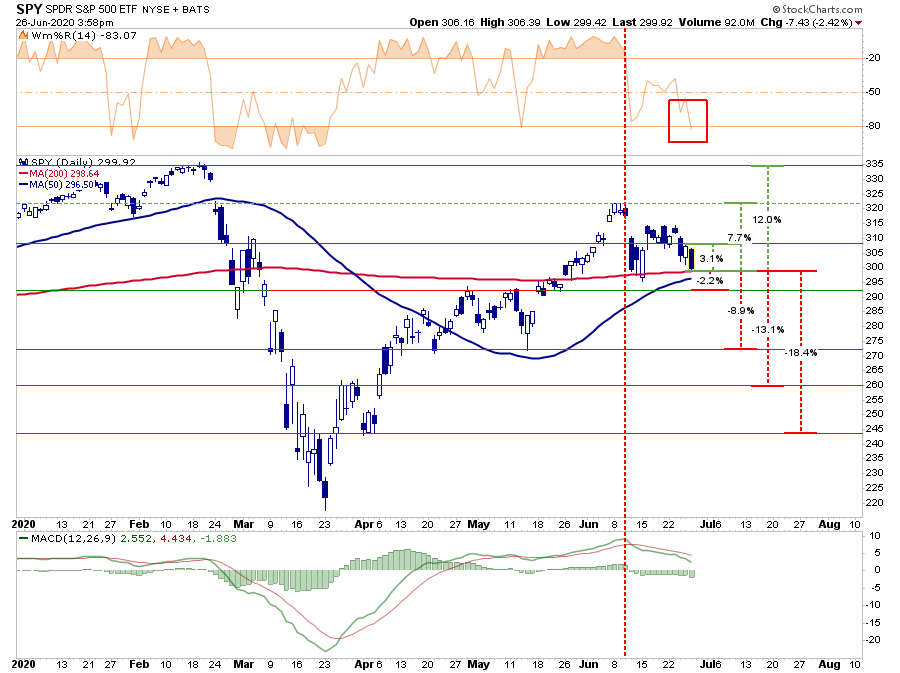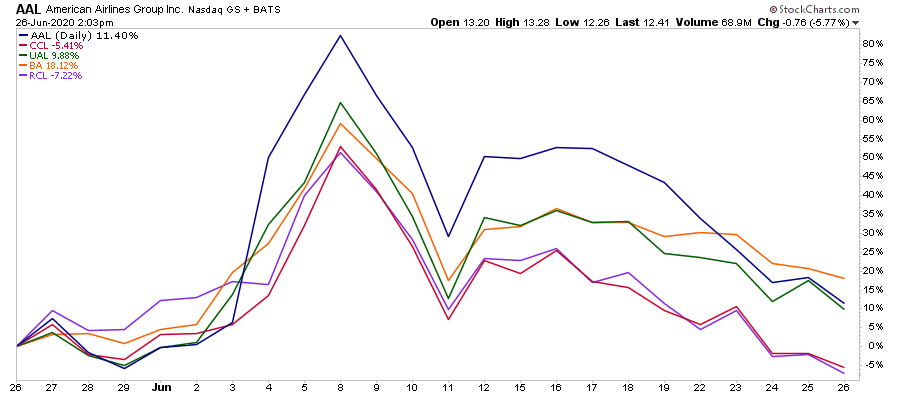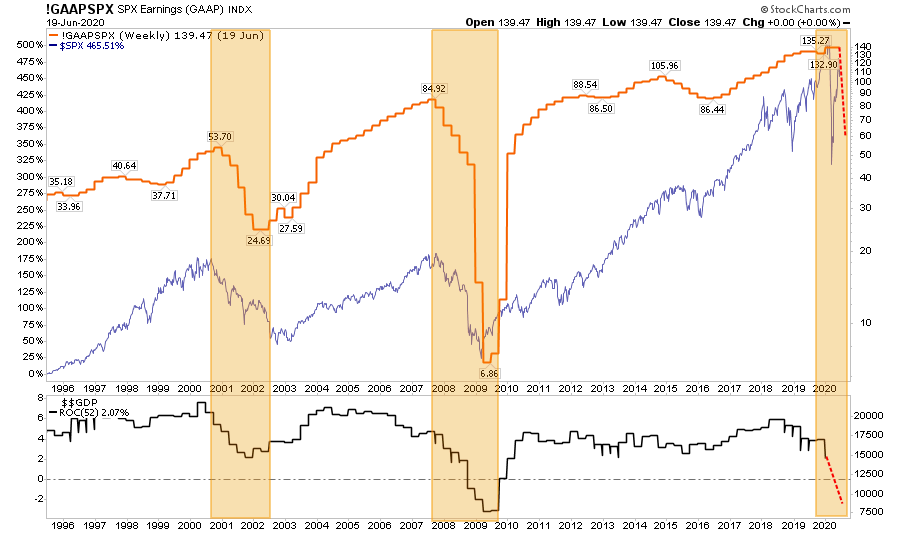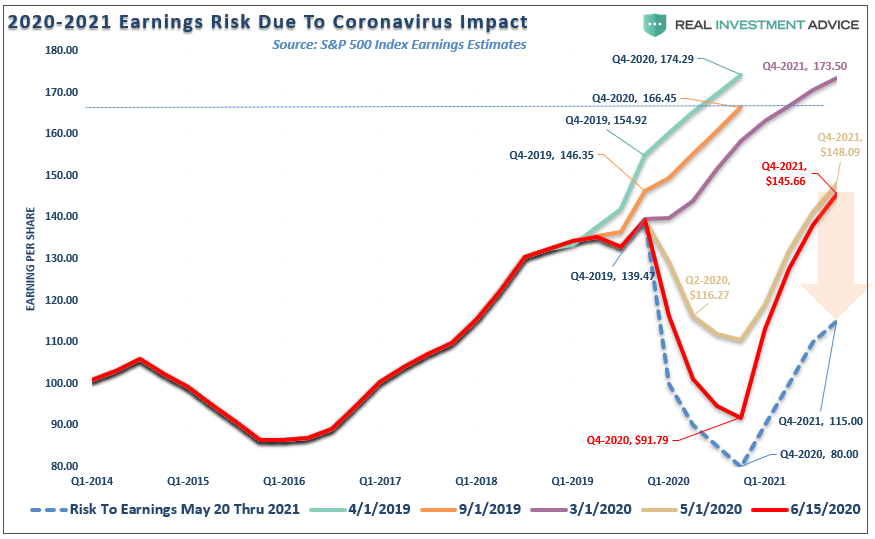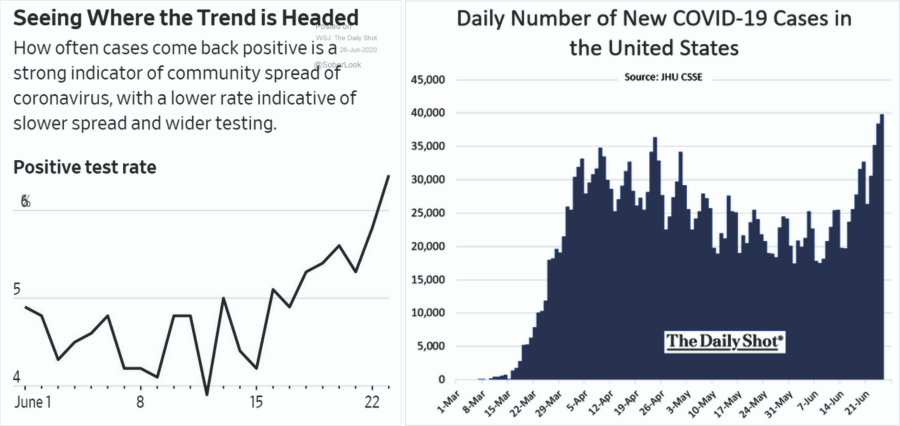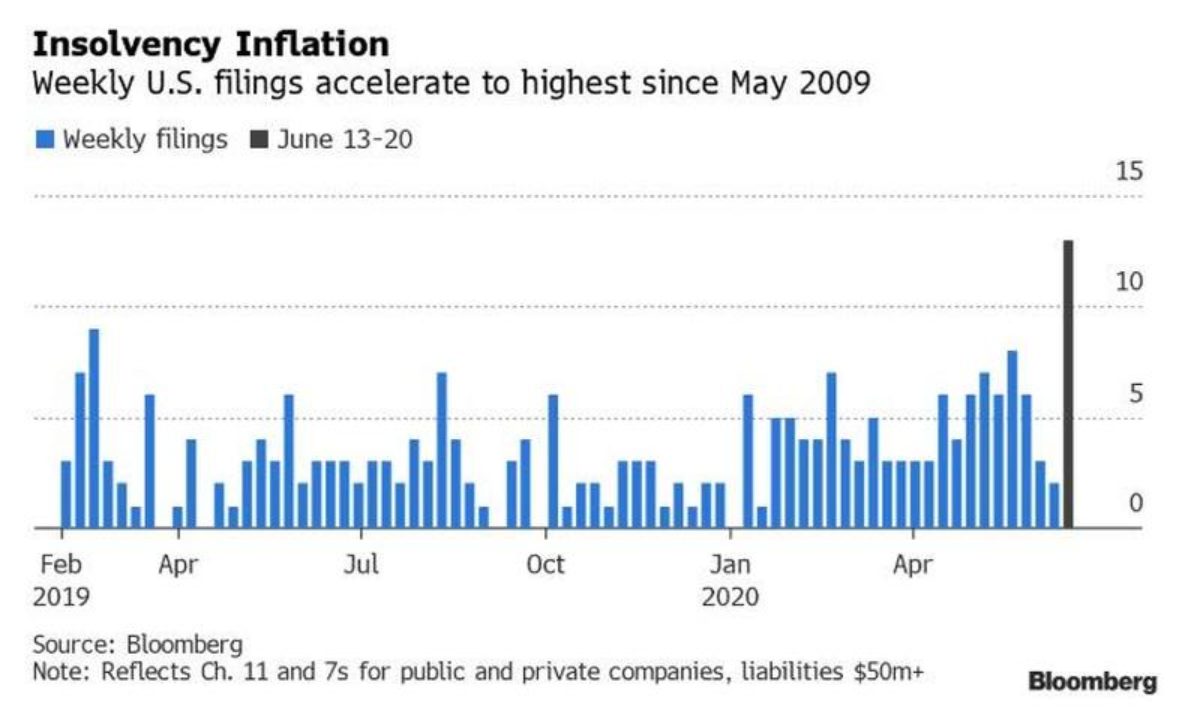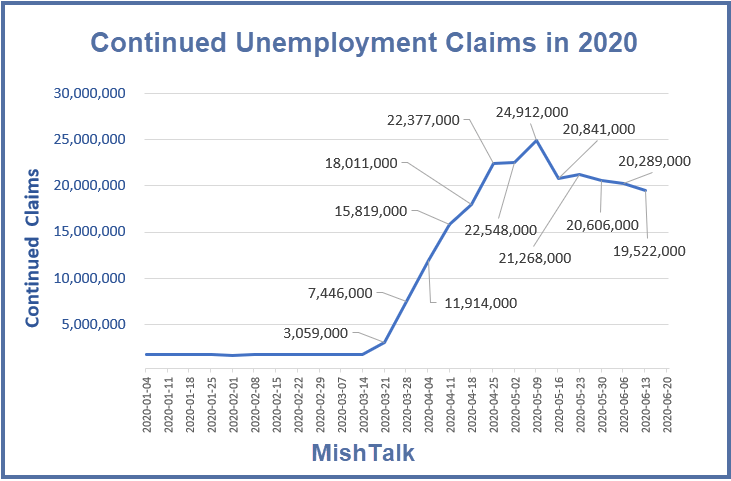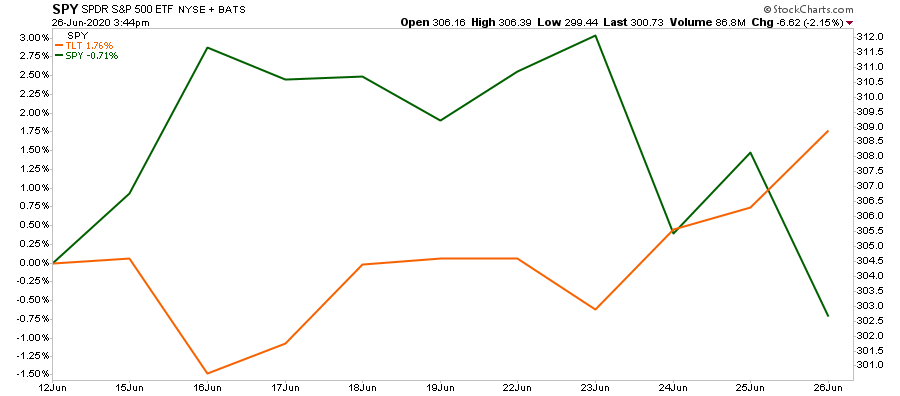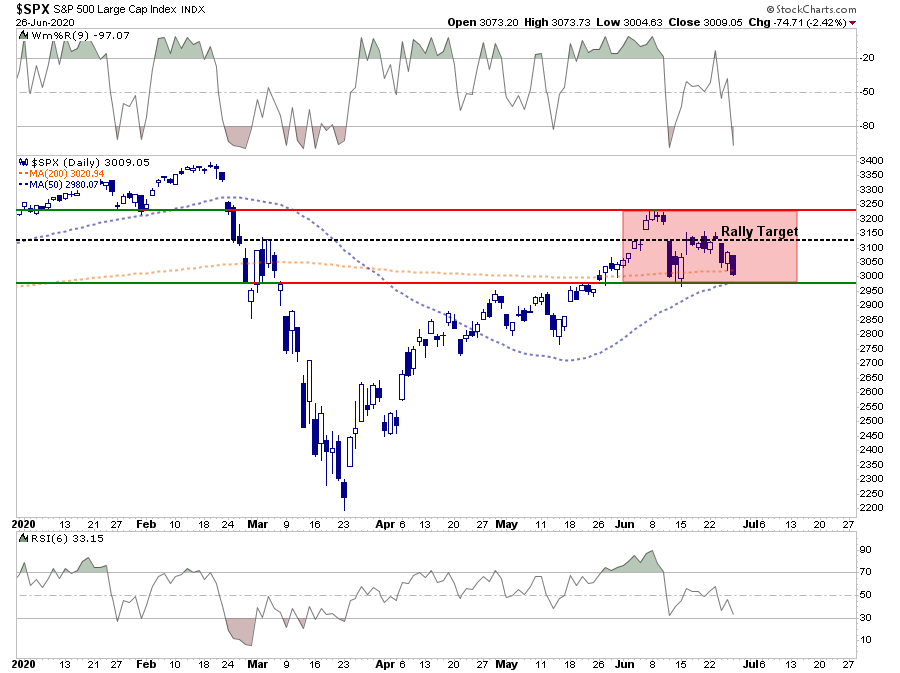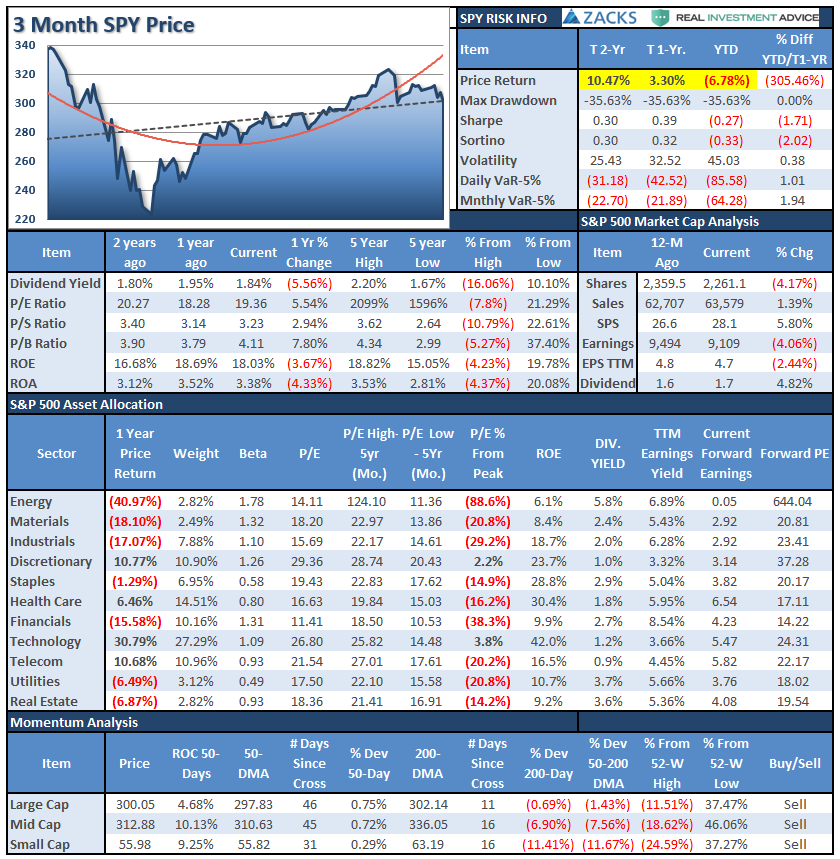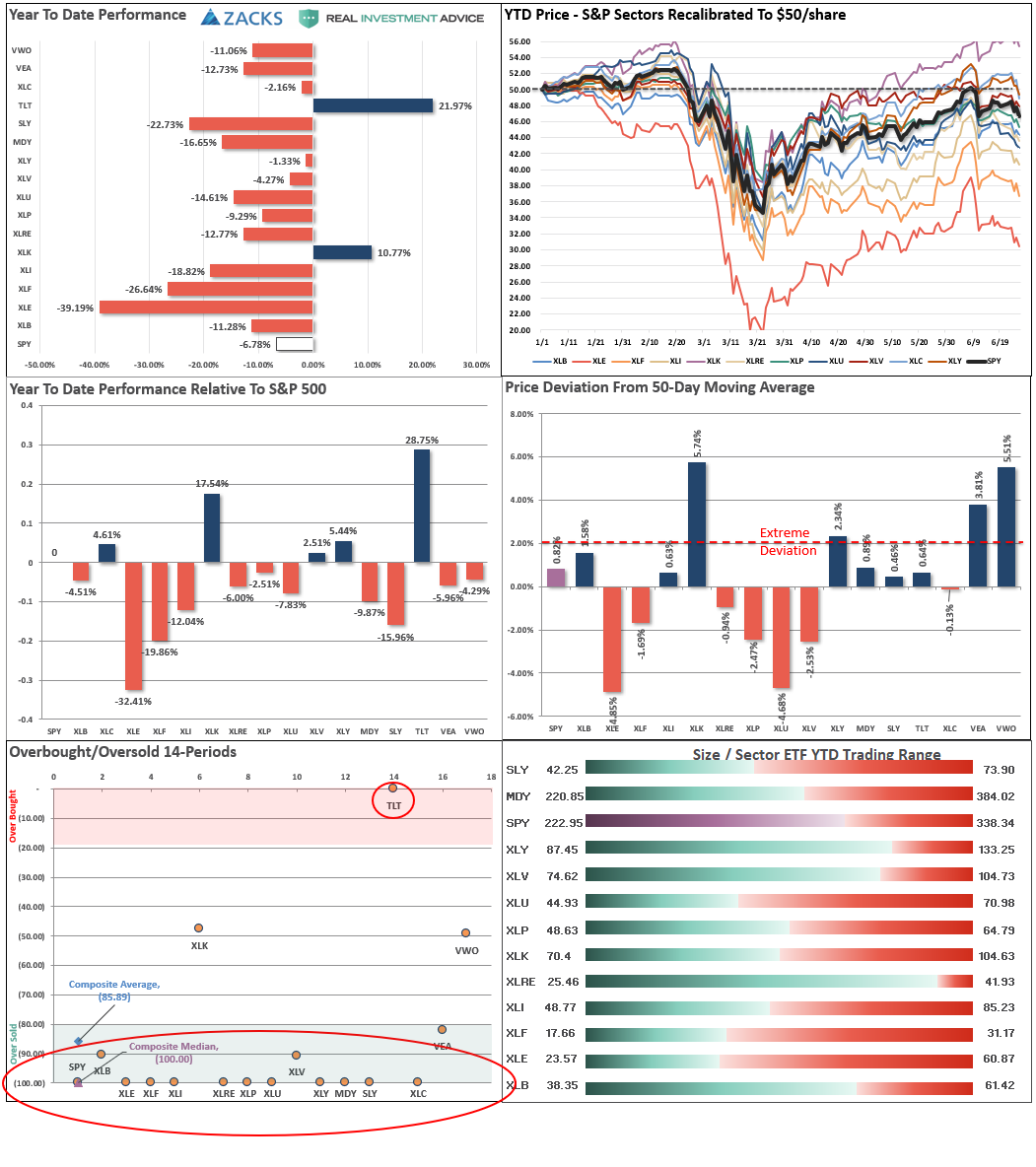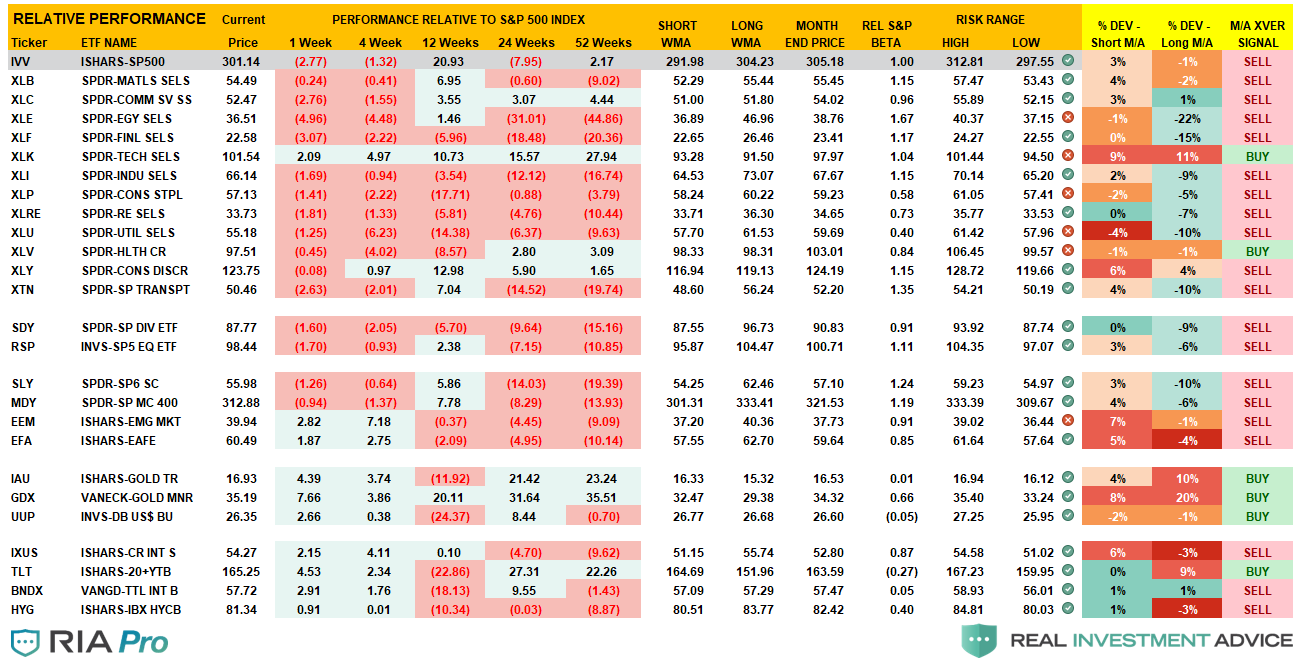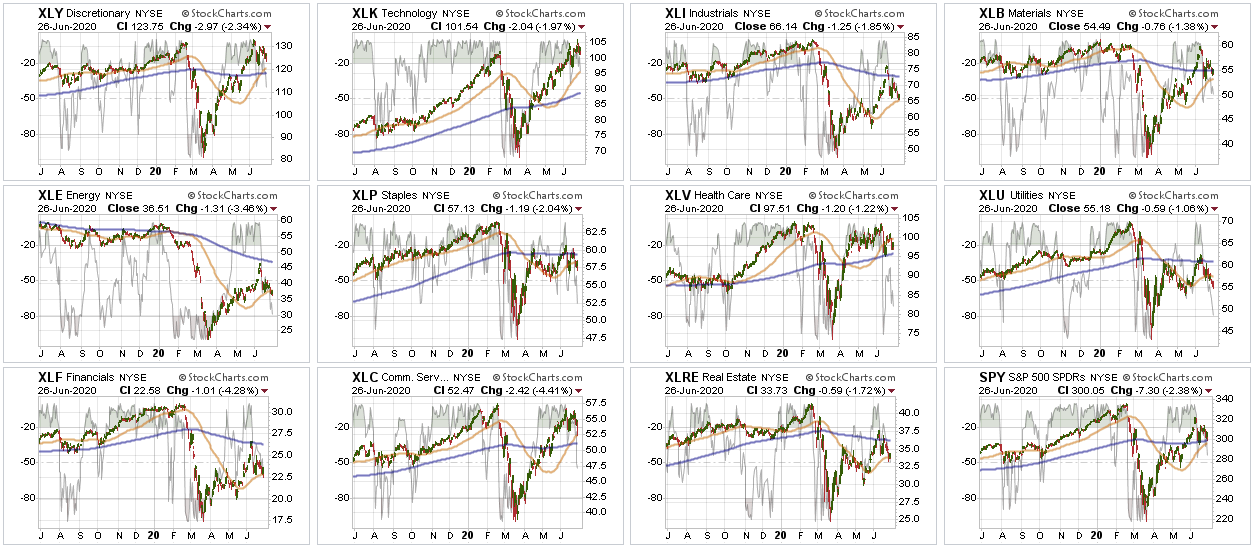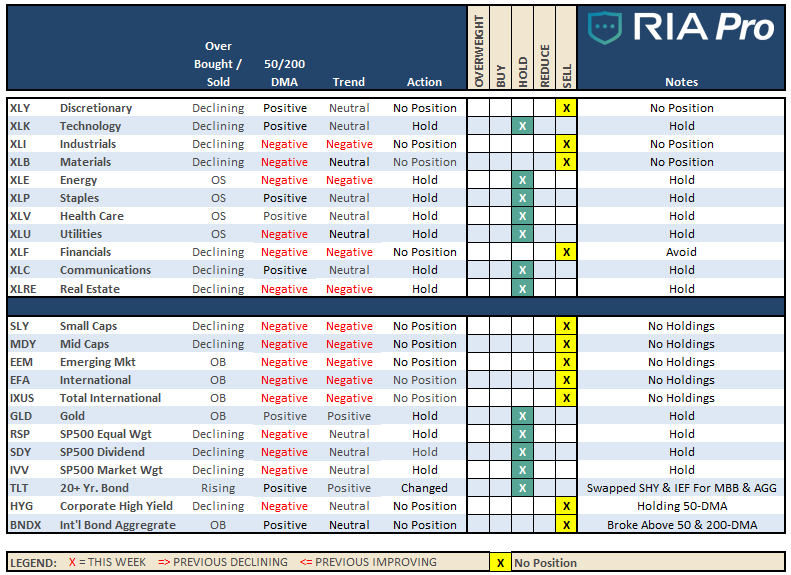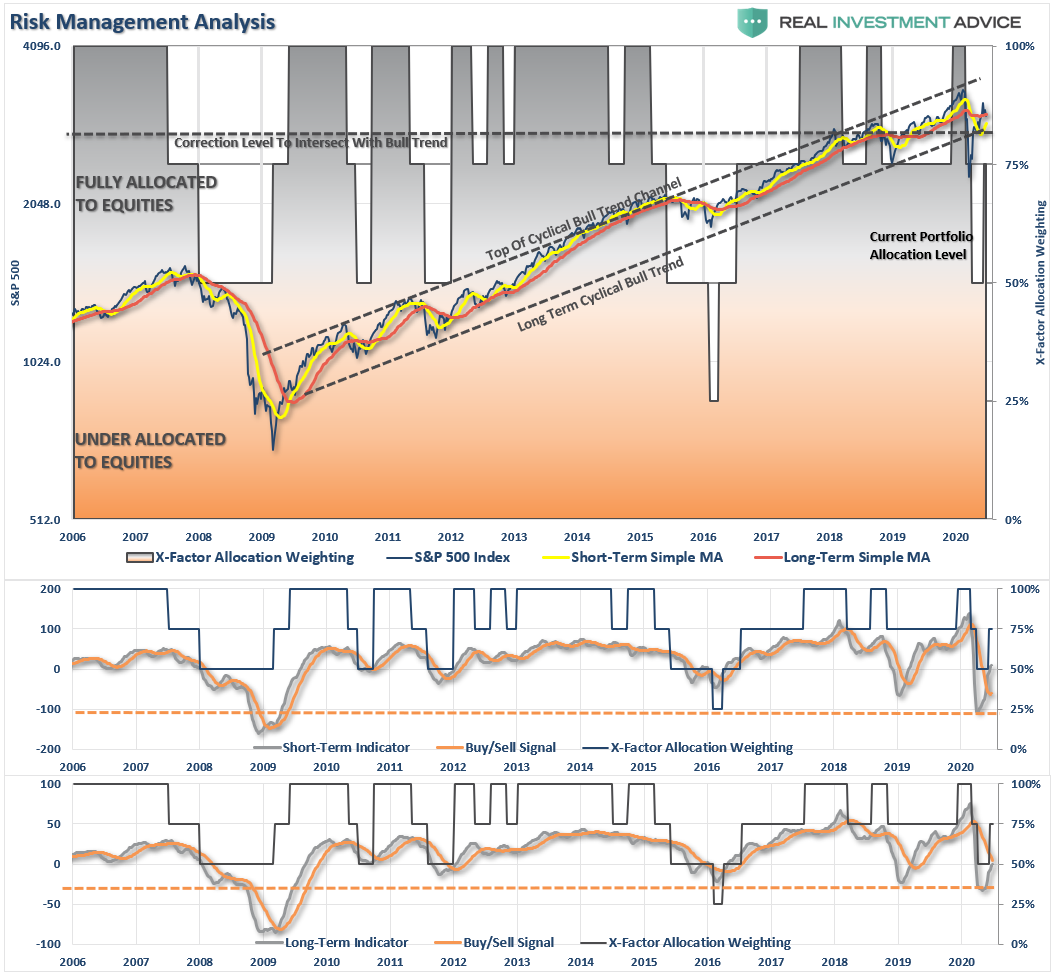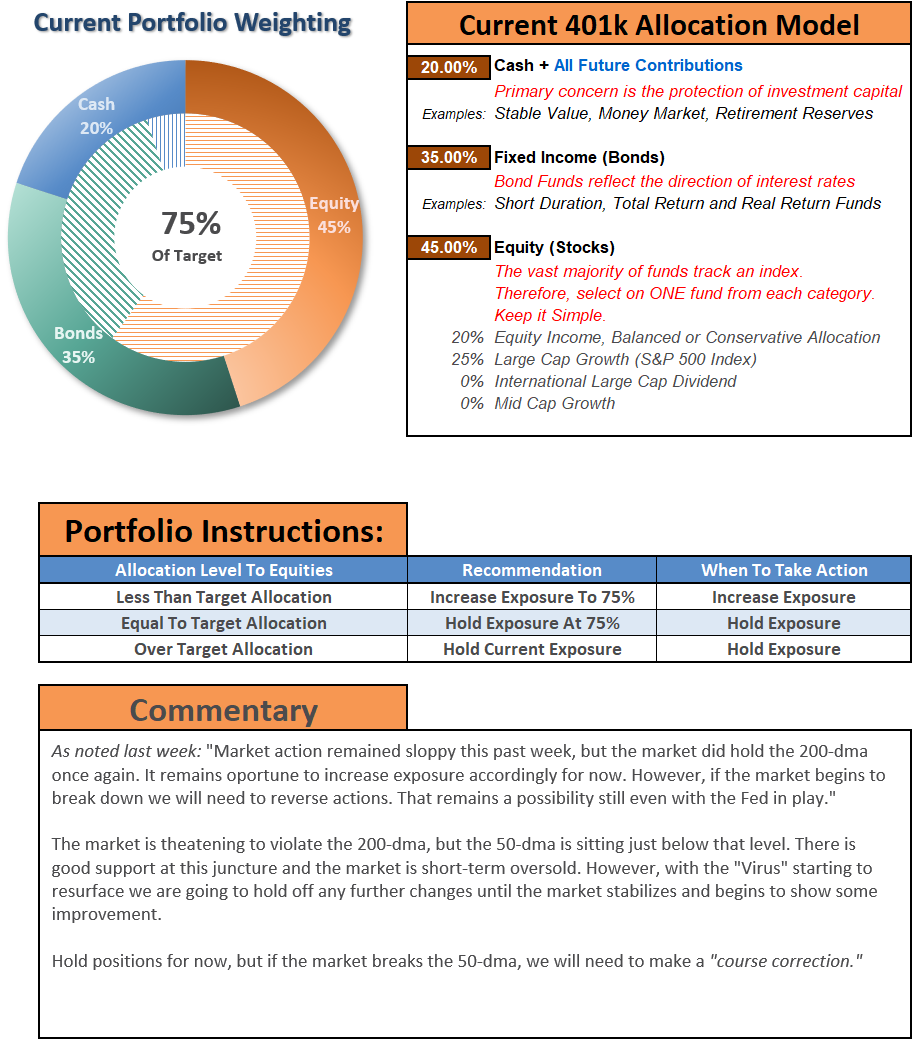In this issue of “Market Corrects As COVID Cases Surge.”
- Market Holds Bullish Support
- From Bubble, To Bust, To Bubble
- The Problem With 2-Year Forecasts
- A Bearish Pattern Remains
- Portfolio Positioning
- MacroView: Rationalizing High Valuations Won’t Improve Outcomes
- Sector & Market Analysis
- 401k Plan Manager
Follow Us On: Twitter, Facebook, Linked-In, Sound Cloud, Seeking Alpha
Upcoming Event – CANDID COFFEE
Sign up now for this virtual “Financial Q&A” GoTo Meeting
July 25th from 8-9 am
Send in your questions, and Rich and Danny will answer them live.
Catch Up On What You Missed Last Week
Note:
I am on vacation next week, so while I will post a newsletter next weekend, it will only be a short market update as I will not have access to all of my usual data. However, I assure you everything will return to normal on my return.
If you have any questions, I will continue to answer every question, every day. That is between sleeping on the beach, fishing, skiing, or eating.
Market Corrects As COVID Cases Surge
Three overriding catalysts were driving the correction this past week:
- The market had gotten a good bit ahead of fundamentals.
- The surge in COVID cases is undermining the V-Shaped recovery narrative.
- End of the quarter portfolio rebalancing, which managers postponed in March.
We will go through each of these in more detail. However, let’s start with where we left off last week and update our risk/reward ranges.
Currently, the risk/reward dynamics have become slightly less favorable. The good news is that the 50-dma and 200-dma are so close there is strong support short-term. Such should give the bulls a bit of optimism. However, a breakdown below that level and things will get ugly quickly.
- -2.2% to consolidation highs vs. +3.1% to the top of the current downtrend. (Positive)
- -8.9% to previous consolidation lows vs. +7.7% to previous rally peak (Negative)
- -13.1% to March bounce peak vs. +12% to all-time highs. (Negative)
- -18.4% to April 5th lows vs. +12% to all-time highs. (Negative)
As shown, with the sell-off on Friday, the short-term oversold condition, a reflexive rally next week would not be surprising. Given that COVID concerns are escalating, it may be wise to use any rally to reduce risk further and increase hedges.
The Market Is Well Ahead Of Fundamentals
Part of the correction over the last two weeks is coming partially from the realignment of stocks back to reality. We specifically mentioned some of the more visible issues last week, but it was interesting to watch the “Daytraders Favorites” crash back to Earth (No pun intended.)
As we addressed on Tuesday, it is hard to justify paying current valuations.
“Furthermore, given the depth of the economic crisis, 49-million unemployed, collapsing wages and incomes, and a resurgence in the number of COVID-19 cases, estimates are still too high. During previous economic downturns, earnings collapsed between 50% and 85%. It is highly optimistic, given the current backdrop, that earnings will only decline by 20%.”
6-Downside Risks
With States now beginning to back off of reopening plans, it is highly likely current earnings estimates will need to be guided lower over the next couple of months.
The most significant risk to investors currently is a “reliance on certainty” about future outcomes, when, in reality, there is no certainty at all. As Mike Shedlock pointed out just recently, there are numerous risks still present.
Six Downside Risks
- The future progression of the pandemic remains highly uncertain.
- The collapse in demand may ultimately bankrupt many businesses.
- Unlike past recessions, services activity has dropped more sharply than manufacturing—with restrictions on movement severely curtailing expenditures on travel, tourism, restaurants, and recreation and social-distancing requirements and attitudes may further weigh on the recovery in these sectors.
- Disruptions to global trade may result in a costly reconfiguration of global supply chains.
- Persistently weak consumer and firm demand may push medium- and longer-term inflation expectations well below central bank targets.
- Additional expansionary fiscal policies— possibly in response to future large-scale outbreaks of COVID-19—could significantly increase government debt and add to sovereign risk.”
Again, the market is trading well ahead of underlying fundamentals. While the “Fed Put” may indeed put a “floor” below stocks, that doesn’t mean they can’t correct to realign with economic and fundamental realities.
COVID Makes A Second Appearance
As we discussed previously, the market rallied from the March lows based on 4-underlying premises:
- There would be no second-wave of the virus.
- There would be a vaccine available by year-end.
- The economy would fully recover back to pre-pandemic levels.
- And, of course, “The Fed.”
While the bullish fantasy indeed prevailed over the last couple of months, suddenly, the world has shifted. The hope was that cases in the U.S. would slow into the fall before the potential onset of a “second wave” during a more traditional “flu season.” Unfortunately, the spike in cases in the still ongoing “first wave” will delay economic recovery longer.
In Texas, where I live, the Governor has shut-down bars again, is keeping businesses at reduced capacity, and potentially will reverse more if needed.
My wife went to the doctor recently for a test, and she received the “ole’ swap up the nose.” While the test came back negative. The doctor told my wife that COVID lives in the lungs and not the nasal cavity. Therefore, while her test was negative, it could be a false negative. If the doctor is correct, the real numbers of infected could be 10x higher. Such confirms a recent Reuters article:
“Government experts believe more than 20 million Americans could have contracted the coronavirus, 10-times more than official counts, indicating many people without symptoms have or have had the disease, senior administration officials said.
The estimate, from the Centers for Disease Control and Prevention, is based on serology testing used to determine the presence of antibodies that show whether an individual has had the disease, the officials said.”
If true, the ramifications could substantially impair the bullish thesis.
Timing Couldn’t Be Worse
Without a bill to extend more Federal Aid via Payroll Protection Programs and increased unemployment benefits, the ongoing restriction on trade will likely lead to a further surge in bankruptcies and layoffs.
“According to Bloomberg data, no less than 13 U.S. companies sought bankruptcy protection last week, matching the global financial crisis’s peak. The filings, led by the perennially weak consumer and energy sectors, were the most for any week since May 2009.”
There is a virtual spiral between job losses and bankruptcies. As more individuals lose their jobs, they have less to spend. Since consumption is what drives earnings for businesses, they have to lay off workers to stay in business. Pay attention to the “continuing claims,” which will tell the story of the economic recovery. (That doesn’t look like a “V”)
End Of The Quarter Rebalancing
There was one other factor which has weighed on stocks this past week, which was noted recently by Zerohedge:
“When adding all the other possible sources of the month- and quarter-end forced rebalancing, the total amount ‘for sale’ soars to an unprecedented $170 billion according to calculations by JPMorgan.
In the latest Flows and Liquidity report from JPM’s Nikolas Panagirtzoglou, writes that after correctly pointing out at the market lows on March 23rd that there is a massive $1.1 trillion in rebalancing flow into equities, all of that has since balanced out, and three months later, we are looking at a substantial outflow of about $170BN before month-end, resulting in a ‘small correction.'”
This rebalancing of portfolios was postponed by pension and mutual funds in March as they did not want to sell at market lows. That decision worked out well then, but now they need to rebalance portfolios by selling equities and buying bonds. We can see this action by looking at the performance between the S&P 500 index and Treasury Bonds over the last two weeks.
This rotation is either likely close to completion, or will complete early next week. As we stated previously, this is why we hedge our equity portfolios with fixed income. The risk offset reduces downside volatility and allows the portfolio to weather tough patches in the market.
With the market very oversold short-term, it would not be surprising to see a reasonably decent reflexive rally into the start of July. However, that rally will likely be an excellent opportunity to rebalance risk and rethink exposures accordingly.
Portfolio Positioning Update
As stated last week, with our portfolios almost entirely allocated towards equity risk in the short-term, we remain incredibly uncomfortable.
Our positioning in fixed income and gold has hedged the portfolio against the latest decline in the very short-term. Still, with the market getting very oversold short-term, as shown below, we expect a reflexive rally off of current support next week.
Most likely, we will use any counter-trend bounce to reduce equity risk a bit, rebalance exposures, and focus our attention on capital preservation for the next couple of months. With the virus resurfacing, the potential risk of disappointment to the earnings and economic recovery story has risen.
While it is easy for the mainstream media to write articles and post comments about the markets, it is an entirely different matter when you manage money. Currently, there is a battle raging between the fundamental and “hope” driven narratives.
On the one hand, it’s easy to see the fundamental problems in the market and the economy, which argues for much less risk exposure. However, on the other, you have the Fed and a Government, ready to throw money at, and “jawbone,” the markets at a moment’s notice.
Trying to navigate the two is like trying to thread a needle, in a moving car, on a bumpy road, with your eyes closed. Given we aren’t prescient, we will have to resign ourselves to doing the best job we can for our clients with the information we have available.
That is a fancy way of saying, “we are going to give it our best guess.”
The goal remains the same as always, protect our client’s capital, reduce risk, and try to come out on the other side in one piece.
Sometimes, however, it just gets messy.
The MacroView
If you need help or have questions, we are always glad to help. Just email me.
See You Next Week
By Lance Roberts, CIO
Market & Sector Analysis
Data Analysis Of The Market & Sectors For Traders
S&P 500 Tear Sheet
Performance Analysis
Technical Composite
Sector Model Analysis & Risk Ranges
How To Read.
- The table compares each sector and market to the S&P 500 index on relative performance.
- The “MA XVER” is determined by whether the short-term weekly moving average crosses positively or negatively with the long-term weekly moving average.
- The risk range is a function of the month-end closing price and the “beta” of the sector or market.
- The table shows the price deviation above and below the weekly moving averages.
Sector & Market Analysis:
Be sure and catch our updates on Major Markets (Monday) and Major Sectors (Tuesday) with updated buy/stop/sell levels.
Sector-by-Sector
Improving – Financials (XLF), Industrials (XLI), and Energy (XLE)
Last week, Financials moved into the improving quadrant of the rotation model, but will likely be short-lived. Recent moves by the Fed to cap buybacks and dividends may add to selling pressure. Materials and Industrial performance overall remains inadequate with a failure at the 200-dma. Energy is deeply oversold and is cheap on a value basis; we may look to add to our exposure again.
Current Positions: XLE
Outperforming – Materials (XLB), Technology (XLK), Discretionary (XLY), and Communications (XLC)
Discretionary, which had gotten very extended, and has corrected this past week. The sector has worked off some of the overbought conditions, so after discussing last week, a “correction” was possible, it has occurred. After suggesting profit-taking the previous week, the same for Communications, both sectors have had a sizable correction are now moving back to oversold. We may have a trading setup by next week. Technology did not correct much this past week and remains short-term overbought. The opportunity may be to reduce Technology and add to Communications and Discretionary.
Current Positions: XLC, XLK, XLC
Weakening – Healthcare (XLV)
Previously, we added to our core defensive positions Healthcare. We continue to hold Healthcare on a longer-term basis as it tends to outperform in tougher markets and hedges risk. Healthcare is now sitting on support and is getting decently oversold. We may see a counter-trend rally next week to rebalance.
Current Position: XLV
Lagging – Utilities (XLU), Real Estate (XLRE), and Staples (XLP)
Our defensive positioning in Staples, Real Estate, and Utilities has lagged but remains part of the “risk-off” rotation trade. We see early signs of improvement, suggesting it is the right place to be. If it turns up meaningfully, we will add to our current holdings.
Current Position: XLRE, XLU, & XLP
Market By Market
Small-Cap (SLY) and Mid Cap (MDY) – Two weeks ago, both of these markets were extremely overbought and susceptible to a pullback. Even with the pullback, neither market is oversold. Both markets are sitting on the last line of support. We maintain no holdings currently.
Current Position: None
Emerging, International (EEM) & Total International Markets (EFA)
Emerging and International Markets have performed better recently, and have not declined as much as the market. However, with the virus on the rise, there is a risk in these markets. Both of the markets are very overbought, so take profits and rebalance if needed. Pay attention to the dollar for your cue as to what to do next.
Current Position: None
S&P 500 Index (Core Holding) – Given the broad market’s overall uncertainty, we previously closed out our long-term core holdings. We are currently using DIA as a “Rental Trade” to pick up some bulk exposure for trading purposes. We tripped our stop on Friday so we will sell the position on any rally next week.
Current Position: None
Gold (GLD) – We currently remain comfortable with our exposure through IAU. Gold is a bit overbought short-term, so we are looking to potentially take some profits and look for a pullback to rebuild exposures.
Current Position: IAU, UUP
Bonds (TLT) –
As we have been increasing our “equity” exposure in portfolios, we have added more to our holding in TLT to improve our “risk” hedge. However, with yields so low, and with the Fed supporting the mortgage-back and corporate bond markets, we swapped our near zero-yielding short-term Treasury funds for Mortgage-Backed and Broad Market bond funds with 2.5% yields. No change this week.
Current Positions: TLT, MBB, & AGG
Sector / Market Recommendations
The table below shows thoughts on specific actions related to the current market environment.
(These are not recommendations or solicitations to take any action. Such is for informational purposes only related to market extremes and contrarian positioning within portfolios. Use at your own risk and peril.)
Portfolio / Client Update
Let me reiterate what I wrote in the main body of this week’s newsletter as it specifically applies to you, our clients.
“Most likely, we will use any counter-trend bounce to reduce equity risk a bit, rebalance exposures, and focus our attention on capital preservation for the next couple of months. With the virus resurfacing, the potential risk of disappointment to the earnings and economic recovery story has risen.
While it is easy for the mainstream media to write articles and post comments about the markets, it is an entirely different matter when you manage money. Currently, there is a battle raging between the fundamental and “hope” driven narratives.
On the one hand, it’s easy to see the fundamental problems in the market and the economy, which argues for much less risk exposure. However, on the other, you have the Fed and a Government, ready to throw money at, and “jawbone,” the markets at a moment’s notice.
Trying to navigate the two is like trying to thread a needle, in a moving car, on a bumpy road, with your eyes closed. Given we aren’t prescient, we will have to resign ourselves to doing the best job we can for our clients with the information we have available.
That is a fancy way of saying, “we are going to give it our best guess.”
The goal remains the same as always, protect our client’s capital, reduce risk, and try to come out on the other side in one piece.
Sometimes, however, it just gets messy.
Changes
We were a little early in both the ETF and EQUITY portfolios, adding back to our energy holdings after taking some gains at the recent peak. After rebalancing our bond holdings previously, TLT performed well in hedging risk this past week, as intended.
With States now starting to reverse reopening procedures, we suspect we will hear something from the Fed next week about more liquidity, or increased interventions. Also, it will not be surprising to see a push by Congress to pass more stimulus very quickly, after all, an “election is a-comin'”
In the short-term, the markets are very oversold, so we will look for a counter-trend bounce to reduce some risk. We have a few positions such as RTX, NSC, and DIA, which violated our stop-levels on Friday, so we will use a bounce to reduce those positions specifically if needed.
In the meantime, we are doing our best to maintain some risk controls to avoid being forced to sell emotionally. In the meantime, please don’t hesitate to contact us if you have any questions or concerns.
Lance Roberts
CIO
THE REAL 401k PLAN MANAGER
A Conservative Strategy For Long-Term Investors
If you need help after reading the alert; do not hesitate to contact me
Model performance is a two-asset model of stocks and bonds relative to the weighting changes made each week in the newsletter. Such is strictly for informational and educational purposes only and should not be relied on for any reason. Past performance is not a guarantee of future results. Use at your own risk and peril.
401k Plan Manager Live Model
As an RIA PRO subscriber (You get your first 30-days free) you have access to our live 401k plan manager.
Compare your current 401k allocation, to our recommendation for your company-specific plan as well as our on 401k model allocation.
You can also track performance, estimate future values based on your savings and expected returns, and dig down into your sector and market allocations.
If you would like to offer our service to your employees at a deeply discounted corporate rate, please contact me.
Lance Roberts is a Chief Portfolio Strategist/Economist for RIA Advisors. He is also the host of “The Lance Roberts Podcast” and Chief Editor of the “Real Investment Advice” website and author of “Real Investment Daily” blog and “Real Investment Report“. Follow Lance on Facebook, Twitter, Linked-In and YouTube
Customer Relationship Summary (Form CRS)
Also Read











